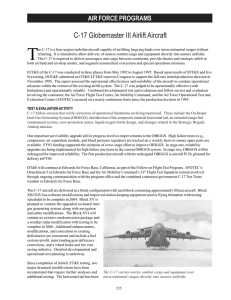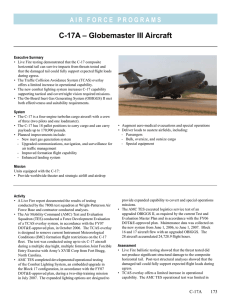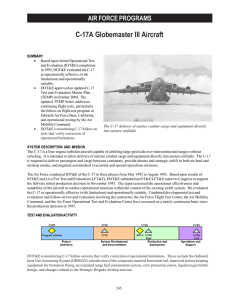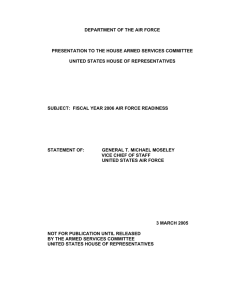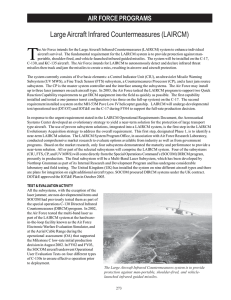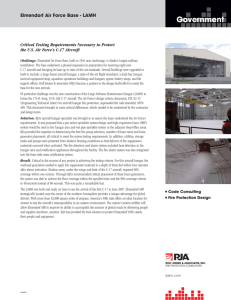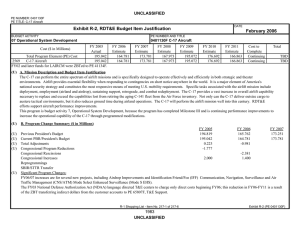,, 1.:;. ‘. .: .,
advertisement
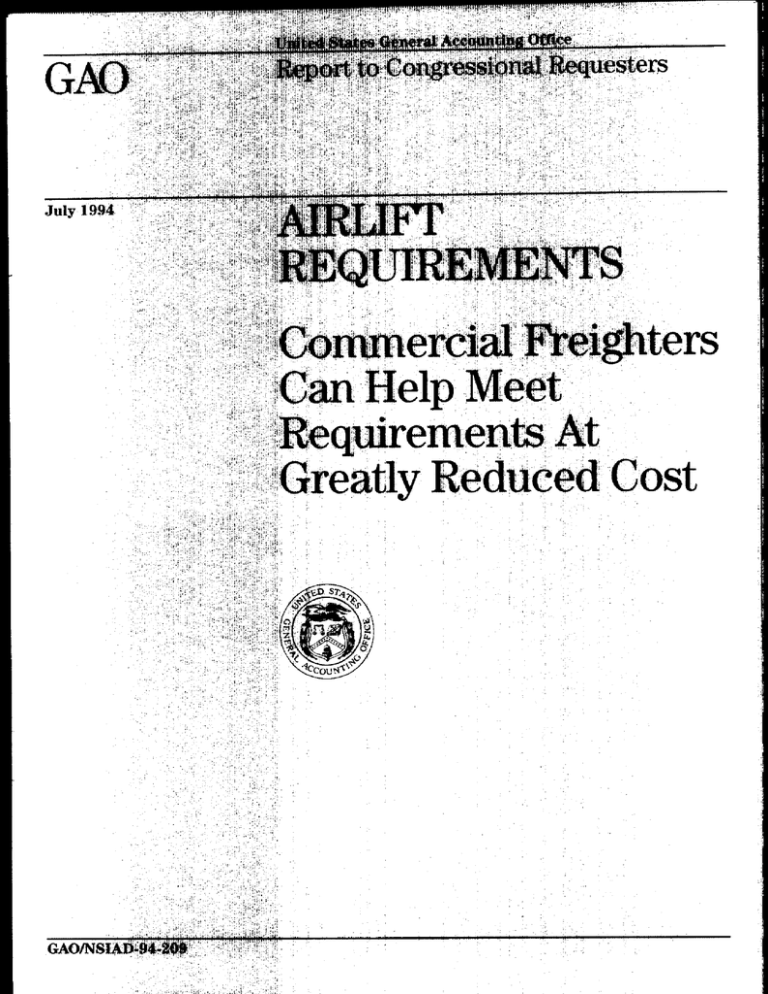
.y: : r ,, ‘. 1.:;. ,. ,i, .: ., ‘,_ : ,, .: .. I ‘” United States General Accounting Office Washington, D.C. 20648 National Security and International Affairs Division B-257743 July 11,1994 The Honorable Sam Nunn Chairman, Committee on Armed Services United States Senate The Honorable Strom Thurmond Ranking Minority Member, Committee on Armed Services United States Senate The Honorable Ronald V. Dellums Chairman, Committee on Armed Services House of Representatives The Honorable Floyd Spence Ranking Minority Member, Committee on Armed Services House of Representatives This report responds to your request for information on the C-17 cost and operational effectiveness analysis (COEA) and to the Fiscal Year 1994 Defense Authorization Act conference report requirement that we report on various aspects of the C-17 program, The report examines some of the assumptions underlying the COEA’Sconclusions and discusses the Department of Defense’s (DOD) ongoing studies to determine the minimum number of G17s needed to perform unique military missions. While recognizing the need for airlift, Congress has directed DOD to explore alternatives to the 12Oaircraft C-17 program.’ The F’iscal Year 1993 Defense Authorization Act restricted the release of C-17 funds, pending a special Defense Acquisition Board review that was held in the fall of 1993. As part of the review, Congress directed that a federally funded research and development center conduct a C-17 COEA,taking into consideration complementary mixes of other aircraft. ‘The Air Force plans to acquire 120 C17s. However, as the result of a 1993 Defense Acquisition Board review, the Deputy Secretary of Defense reduced the program to 40 aircraft for a provisional period, pending another Board review in November 1996.The provisional 4&aircraft program is estimated to cost about $21.3 billion. Page 1 GAOiNSIAD-94-209 Airlki’t Requirements B-257743 The COEA,conducted by the Institute for Defense Analyses (IDA), was submitted to Congress in May 1994. Alternatives to the fulI C-17 program included (1) restarting the C-5 line, (2) extending the service Iife of the C-141, and (3) procuring modified commercial freighter aircraft. IDA examined the delivery capability of different airlift fleets to meet the 30-day moderate risk requirement identified in DOD'S 1992 Mobility Requirements Study (MRS) for concurrent major regional conflicts in Southwest Asia and Korea2 Operational data for range and payload were used for all aircraft except the C-17, which is stiII undergoing test and evaluation. IDA based the C-17’s range/payload performance on Air Force estimates of the aircraft’s capability based on an operational methodology, rather than the more stringent traditional methodology reflected in the current contract. (See app. I for a discussion of other aspects of the cow) IDA concluded that, based on throughput (tons of cargo delivered in a given time frame), a fleet of 120 C-17s was the preferred choice, despite the fact that it was more expensive than a fleet comprised of C-17s and modified commercial freighters. This conclusion was based on three major assumptions: airfield availability for airlift use would be constrained to Operation Desert Shield levels; 9 the C-17 would achieve a f5.2-hour a day utilization rate while commercial freighters would achieve only a 12.5hour a day rate; and the C-17 would be used routinely in place of the C-130 to accomplish intratheater delivery, so C-130 operating and support costs should be added to non-C-17 akernatives. l l IDA also concluded that, based on alternative assumptions, a mixed fleet of 40 C-17s and 64 modified commercial freighters could meet the MRS requirement. IDA'S analysis showed that this mixed fleet would cost $6 billion less than the C-17 fleet. We focused our review efforts on comparing the 120-aircraft program to the mix of 40 C-17s and 64 modified Boeing 747 freighters because this alternative was substantially less expensive than others and met airlift requirements3 2This moderate risk requirement is based on the delivery capability of the airlift fleet assumed avsilable for the MRS. That fleet included 80 C-173 excluding backup and training aircraft. The ME3 moderate risk requirement fell below the theater commsn ders’preferred requirement, which was fiscxdly unachievable. 3For commercial freighters to be viable alternatives to the full C-17 fleet, they must be able to accommodate the Army’s new 2.6- and &ton trucks The aircrafts’ floors would need to be strengthened and, in addition, the side doors would need to be widened or the trucks would have to be fitted with collapsible cab tops. The COEA reflects the estimated cost and performance of these modifications. Page2 GAONXAD-94-209AirIift Requirements B-257743 P B-267743 depending on how these factors interrelate. During Desert Shield/Storm, for example, airfields had a different daily MOG value for every aircraft type.4 IDA examined three MOG cases in the COEA.The first case reflected the airfield assumptions used in the MRS Southwest Asia scenario, in which a sizeable infrastructure would be available to accommodate aircraft unloading, refueling, and servicing. The second case reflected the limited airfield availability in Saudi Arabia that was experienced during the Ilrst 45 days of Desert Shield. The third case coupled the Desert Shield MOG condition in Saudi Arabia with severely reduced MOG in the Korean scenario. C-17 Fares Better W ith Limited Airfield Availability The C-17 fared best relative to the alternative fleets when MOG was extremely constrained. Under IDA'S analysis of the MOG assumption based on the airfield availability used in the M M Southwest Asia scenario, the mixed fleet of 40 C-17s and 64 747s met the airlift requirement and cost about $6 billion less than the fleet of 120 (2-17s.Under the more severe airfield constraints, the C-17 fleet met the requirement, but the mixed fleet was not able to deliver all required outsize equipment in the compressed timefiamesetforthinthe ~~~.Thiscasereflectstheexperience ofDesert Shield, when only one major airlift airfield was available during the first 6 weeks of that deployment. The limited airfield availability was due primarily to the Saudi Arabian government’s reluctance to allow U.S. access to multiple airfields and the U.S. Army’s preference to deploy to only one major airfield. In Desert Shield/Storm, Iraqi troops became entrenched shortly after the invasion of Kuwait and did not invade Saudi Arabia The MRS scenario, on the other hand, postulated that an aggressive enemy was moving directly into Saudi Arabia and that, therefore, the Saudi reluctance to open additional airlift airfields was overcome. IDA'S conclusion that the C-17 was the preferred choice was based on Desert Shield airfield assumptions. However, the COEXwas based on the imminent threat assumed in the MFG.Therefore, we believe the M R S airfield availability assumptions are more realistic than those based on Desert Shield experience. Under the MRS airfield case, the effectiveness of the C-17 fleet declines, relative to the mixed C-17kommercia.l fleet. Figure 1 illustrates the effect of reduced MOG on the delivery capability of the airlift alternatives for outsize cargo. 4At the request of the Office of the Secrebry of Defense, the EUND Corporation is evaluating MOG, with the intent of establishing a well-defined and accepted methodology for understanding and calculatingMOGvalues. Pa.ge4 GACUNSIAD-94-209AirliftRequirementa B-257743 Figure 1: the Effect of Reduced MOG on Outsize Delivery Capability 60 Outsize cargo delivered in 30 days (kilotons) 45 M R S reference line 40 __-______-_--__-__ 9”--- __-_- -----LL---- -____- 35 48 50 Z-Year cumulative 52 54 coat (dollars l Cl7 @ Mixed C-17lcommercial 56 58 60 62 64 in billions) fleet aMRS airfield availability. bDesert Shield airfield availability. Under the scenario where airfield access was severely constrained in Southwest Asia and Korea, both alternatives fell short of the MRS requirement, but the C-17 fleet delivered substantially more outsize cargo. C-17’s Cost-Effectiveness Depends on High Utilization Rate fleets when its projected 15.2 hour per day uGliz.ation rate is assumed. An aircraft’s utilization rate is the planned average daily flying hours per aircraft for the entire fleet. The rate is comprised of numerous elements and is a critical element in cost-effectiveness assumptions. Factors affecting a utilization rate include mission capable rate, number of ah-craft in the fleet and number of aircrews per aircraft, funding for spares, time required to load and unload the aircraft, number and type of airfields available in a given scenario, distance to the theater of operations, and number of aircraft the Joint Chiefs of Staff plans to withhold to perform other critical missions. Page 6 GAO/NSIAD-94-209 Airlift Requirements B-257743 The C-17’s planned utilization rate of 15.2 hours per day exceeds that of any other military airlifter and will not be demonstrated under the contract. The Air Force plans to attain the planned rate by fully funding C-17 spares and maintaining a 5 to 1 aircrew to aircraft ratio. The Air Force has historically underfunded wartime spares for its other strategic airlifters, and those air-lifters have a lower crew ratio than that planned for the C-17. In addition, the COFJA is based on a lower utilization rate for commercial aircraft than has been demonstrated in commercial use and that could be attained if aircrews for these aircraft were funded to levels projected for the C-17. We believe that using comparable utilization rates for the C-17 and alternative aircraft would be a more realistic comparison. The COEA showed that the C-173 effectiveness declines when the utilization rate is lowered, and the mixed C-17kommercia.l fleet’s effectiveness increases as the rate for commercial freighters is increased. IDA found that, based on a 15.2-utilization rate, a fleet of 120 C-17s would deliver about 9 percent more outsize cargo than a mixed fleet of 40 C-17s and 64 commercial freighters. However, the mixed fleet also met the MRS requirement and cost $6 billion less. If the C-17’s contracted utilization rate of 12.5 hours were assumed, the C-17 would deliver only about 4 percent more outsize cargo than the mixed fleet, at a cost of about $4 billion more.6 Under this case, both alternatives fell short of the MRS requirement, Figure 2 shows outsize deliveries under different utilization rate assumptions. % the utilization rate decreases, the lifecycle cost also decreases due to the reduced need for spares and aircrews. Page 6 GAORWAD-94-209 Airlift Requirements B-257743 Figure 2: Outsize Deliveries With Varying C-17 Utilization Rates 50 Outsizecargo delivered in 30 days (kilotons) 45 a MRS reference line 40 ________ ______---- ---------------b / 35 48 50 25-Year cumulative 52 l c-17 @ Mixed C-17kommerciat 8i5.2 C-17’s Projected Utilization Rate May Not Be Achievable 54 cost (dollars hour utilization rate. b12.5 hour utilization rate. 56 56 60 62 64 in billions) fleet To sustain the Air Mobility Command’s 15.15 ho& utilization rate, the C-17 must achieve predicted reliability, maintainability, and availability parameters needed to maintain a planned mission capable rate. In addition, the Air Force must fully fund C-17 spare parts and &crews at levels substantially higher than those of other strategic airlifters. The Command bases its 15.15 hour utilization rate projection on a mission capable rate of 90 percent. However, the C-17 contract specification requires the C-17 to demonstrate a mission capable rate of only 82.5 percent, compared to a rate of 80 percent for the C-141 and 75 percent for the C-5. An 82.5-percent mission capable rate would yield a 13.77-hour per day utilization rate for the C-17. While we cannot precisely quantify the impact of the lower mission capable rate, we believe the delivery capability would decrease. 6While the utilization rate used in the COEX was 15.2.hours, the Co mmand is planning for an actual utilization rate of 15.15 hours. Page 7 GAO/NSlAD-94-209 Airlift Requirements B-267743 Reliability, maintainability, and availability factors are critical determinants for an aircraft’s mission capable rate. As we recently reported,7 the C-17 has fallen short of predicted reliability goals during the flight test program. C-17 reliability data show that a large variety of different failures have occurred, with no one particular item causing the low reliability numbers. To improve reliability, the contractor will have to implement corrective solutions for a substantial number of failures. If the reliability does not improve, the C-17 is not likely to achieve its planned mission capable rate, Another significant contributor to utilization rate is the degree to which spares and aircrews are funded. In 1990, we reported’ that shortages of serviceable peacetime operating spares to support the Air Force’s C-5 and C-141 flying hour programs had led the Air Force to rely on war reserve spares to support peacetime operations. As a result, the level of war reserve spares had decreased to a point at which the aircrafts’ ability to sustain projected wartime utilization rates was questionable. Data for 1993 show that the C-5 and C-141 had only 60 percent and 61 percent, respectively, of their required readiness spares packages filled. Air Force officials acknowledge that spares have not been adequately funded in the past. However, they expect that the spares levels for the C-17 will be fully funded, in part, because spares funding has recently been made a higher priority for the Air Force. An aircrew to aircraft ratio of 5 to 1 is planned for the C-17. The ratios for the C-141 and C-5 are 3.29 to 1 and 3 to 1, respectively. The higher the aircrew ratio, the more hours per day the aircraft can be flown. Therefore, the relatively higher C-17 aircrew ratio contributes to the C-17’s ability to maintain a higher utilization rate than other strategic airlifters. For the C-17 to maintain the planned aircrew to aircraft ratio, Air Force funding requirements will have to be fully met. Higher Utilization Rate for Commercial Aircraft Increases Capability The projected utilization rate for alternative aircraft is as important as the rate for the C-17. The COEAassumed a 12.5-hour utilization rate for the 747 freighter, based on a 3.5- to l-aircrew to aircraft ratio. However, DOD officials agree that the 747 has demonstrated a higher rate in commercial ‘Military Airlift: The G17 Proposed Settlement and Program Update (GAOJT-NSIAD-94172, Apr. 28, 1994). *Military Airlift: Peacetime Use of War Reserve Spares Reduces Wartime Capabilities (GAO/NSIAD-90-186, June 25, 1990). Page 8 GAOINSMD-94-209 Airlift Requirements B-257743 use. A recent Air Mobility Command analysis shows that the utilization rate could increase to at least 15.2 if a 5 to 1 aircrew ratio were funded. IDA analyzed the effect of increasing the 747’s rate to 15.2 hours9 The results showed a significant increase in the Gl7kommercial fleet’s ability to deliver outsize and oversize cargo. The mixed fleet exceeded the MRS outsize cargo requirement by about 1,000 tons and cost about $6 billion less. This mixed fleet also delivered about 8,000 more tons of oversize cargo than the C-17 fleet, well above the MRS requirement. IDA, however, did not examine cases with a utilization rate of 15.2 for the 747 coupled with a lower C-17 rate+ Intratheater Airlift Assumptions Do Not Reflect C-17’s Planned Role The C-17 was designed to deliver cargo to small, forward airfields typically used by the C-130. Consequently, past Air Force studies have presumed that, as the C-17 fleet became operational, some C-130s would be retired. IDA’S analysis assumed, therefore, that the alternative with only 40 C-17s would need 80 additional C-130s to provide about the same intratheater movement capability as the fleet of 120 C-17s. Thus, IDA added C-130 operating and support costs of $4 million per aircraft per year to the mixed fleet alternative.1o However, we believe it was inappropriate for IDA to do so, because the C-17’s planned intratheater role has been largely limited and the Air Force does not plan to replace C-130s with C-17s for intratheater missions. C- 17’s Intratheater Will Be Limited When a program of 210 C-17 aircraft was planned, the Air Force anticipated that, during a contingency, C-17s would routinely deploy to the theater of operations to conduct intratheater missions as needed. These missions are typically carried out by C-130s or ground transportation. Current Air Force policy, however, reflects a substantially diminished intratheater role for the C- 17. The Command’s 1993 Airlift Master Plan makes no mention of the C-17’s potential to conduct intratheater missions. Air Force officials acknowledged that while C-l 7s will provide addition& Role gWhen IDA began its analysis, it used primary authorized aircraft numbers, which excluded backup and training aircraft. The 747 utilization rate excursions were based on 40 C-17 and 47 747 primary authorized aircraft, or a total fleet of 47 G17s and 49 747s. As a result of the Defense Acquisition Board’s discussions, however, IDA began using total aircraft inventory numbers, which included all aircraft in the fleet. Subsequent IDA analysis, therefore, was based on a total fleet of 40 C-17’sand 64 747s. loPast studies, such as the 1983 Airlift Master Plan, added C-130 procurement and operating and support costs to non-C-17 options. Page 9 GAiNhWAD-94-209 Airlift Requirements B-25 7743 in&&heater delivery of outsize cargo when needed, they will not routinely perform intratheater missions as originally planned. The C-17’s diminished intratheater role is due primarily to the Secretary of Defense’s 1990 decision to reduce the number of C-17s from 210 to 120 aircraft because of the diminished Soviet threat. Under the current 120-aircraft program, the inter-theater airlift flow-missions from the continental United States to the operational theater, for example-would be adversely affected if aircraft were diverted to perform intratheater missions. A diversion would be particularly damaging during the critical first 30 days of a conflict. The CC&I increased the life-cycle cost of the alternative with 40 C-17s and 64 747s by $320 million per year to reflect operating and support costs for 80 C-130s. Over a 25year life-cycle, this alternative would incur an additional cost of $4.7 billion. When this cost is subtracted from the mixed fleet, the cost savings as compared to a fleet of 120 C-17s increases from about $6 billion to about $10.7 billion. COEA Was Not Intended to Assess Minimum Number of C-17s Needed to Fulfill Unique Military Requirements Determining the proper mix of C-17s and commercial freighters depends on the fleet’s capability to fulfill certain unique military requirements that the COEA was not intended to address in detail. These missions include strategic brigade airdr~p;~’ combat offload; direct delivery to small, austere airfields; intratheater airlift of outsize cargo; aerial refueling; and aircraft survivability. DOD has several studies underway, scheduled to be completed by the November 1995 Defense Acquisition Board decision on C-17 full-rate production, that will assess the capability of various fleet mixes to fulfill unique military airlift requirements. The Air Force is conducting a multifaceted study to provide DOD decisionmakers with information necessary to determine the type and number of nondevelopmental airlift aircraft (NDAA) to procure. The study will determine the cost-effectiveness of airlift fleet mixes comprised of C-17s and military and commercial NDAAS, based on the airlift requirements identified in a new MRS, expected to be completed in December 1994. This study will consider the need for unique military airlift capabilities that the COEA did not address. “IDA asserts that each fleet mix assessed in the COEL4is capable of performing the strategic brigtie airdrop mission, a Joint Chiefs of Staff requirement. For the mixed G17kommerciaI fleet to fulfill this mission, the existing C-5s would have to be modified. The Air Mobility Co mmand is currently determining the feasibility of the necessary modifications. Page 10 GAO/NSIAD-94-209 Airlii Requirements B-257743 The Air Force study will also assess the operational use of wide-body commercial aircraft in moving bulk and oversize cargo. A key component of this assessment was a loadability study, conducted in May 1994, to determine the time required to load oversize vehicles onto commercial freighters such as the 747. The Air Force is compiling the results of the study. As currently planned, NDAA source selection and quantity will depend on the C-17 full-rate production decision. The Defense Acquisition Board will consider several factors in deciding whether or not to continue the C-17 program, including C-17 flight test and reliability results, contractor performance, and the findings of the Air Force’s airlift fleet mix study. Matter for Congressional Consideration IDA'S conclusion that the C-17 was the preferred air-lifter was based on assumptions that are questionable. Therefore, Congress should not consider the COJZA as a basis for authorizing 120 C-17s. The minimum number of C-17s needed to fulfill military requirements has yet to be determined. Views of Agency Officials and Our Observations As agreed with your offices, due to time constraints, we did not obtain written agency comments on this report. However, we discussed our findings with agency officials. We also shared the results of our work with IDA officials, who stated that our depiction of the COEAwas accurate and offered minor technical observations that have been incorporated in the report. Air Force and Air Mobility Command officials believed that the Desert Shield/Storm MOG condition in the COEA should be considered the baseline airfield case. DOD officials noted that, because many factors affect MOG, it cannot be assumed that the airfields used in the MRSwill be available in future contingencies. The officials noted that likely airfield availability may, in reality, lie between the Desert Shield/Storm and the MRS MOG conditions. However, this MOG value has not yet been quantified. While we agree that MOG is a complex formula that encompasses many factors, we believe that one of the key constraining factors demonstrated in Desert Shield-Saudi reluctance to grant U.S. access to numerous airfields--is unlikely to occur in an Mm-type Southwest Asia scenario, In our opinion, Saudi reticence would be much less likely in the face of an imminent threat as postulated in the MRS. In Desert Shield, because Iraqi forces did not invade Saudi Arabia, allied forces had the advantage of a 5-month Page11 GAO/NSIAD-94-209Airlift Requirements B-257743 deployment period. Therefore, the rigorously restricted Desert Shield MOG assumption is, in our opinion, not a valid basis for comparing the C-17 to alternative airlift fleets. DOD and Air Force officials acknowledged that the C-17 will not demonstrate a l&2-hour utilization rate until the fleet is mature. However, they believe that if the program is adequately funded, the C-17 is capable of achieving this rate. They also noted that the 12.5-utilization rate required in the contract applies only to the reliability, maintainability, and availability evaluation. Air Mobility Command officials commented that, if commercial NDAA are procured, almost all will be kept in the Associate Reserves, as opposed to active duty squadrons. Therefore, they stated that it will not be feasible to increase the 747’s utilization rate to levels comparable to the C-17’s We recognize that, operationally, the C-17 may be able to demonstrate a 15.2-utilization rate and the 747 may be held to a lower rate than it could theoretically achieve. However, we believe that for the purposes of a COEA,comparable utilization rates for the C-17 and the 747 would be a more legitimate basis for comparison. DOD and Command officials agreed with our findings regarding the C-17’s intratheater airlift role. However, some Air Force officials stated that, because the C-17 is capable of performing intratheater missions, it should be credited with some cost savings as a result, even though this role has been limited. We continue to believe that, given the reduced number of C-17s, it is unlikely that the C-17 will perform routine intratheater missions during the first 30 days of an MRs-type conflict. Therefore, C-130 operating and support costs should not be added to alternative fleets in a COEA. Scope and Methodology We reviewed the COEA and discussed it with officials from IDA, the Office of the Secretary of Defense, the Air Force, and the Air Mobility Command. We also referred to our past and ongoing work on airlift and various aspects of the C-17 program. We focused on those assumptions that, in our opinion, were most significant in determining the relative cost-effectiveness of the C-17 and the most cost-effective alternative fleet mixes. We conducted our review from May to June 1994 in accordance with generally accepted government auditing standards. Page 12 GAONXAD-94-209 Airlift Requirements B-267743 As you requested, we plan no further distribution of this report until 7 days after its issue date. At that time, we will send copies to the Secretaries of Defense and the Air Force; the Director, Office of Management and Budget; and other interested parties. Copies will also be made available to others on request. Please contact me at (202) 512-4841 if you or your staffs have any questions concerning this report. Major contributors to this report were Thomas J. Denomme and MicheIe Ma&n. Louis J. Rodrigues Director, Systems Development and Production Page 13 GAO/NSLAD-94-209Airlift Requirements Appendix I Additional Information on Requirements and Cost Data in the Cost and Operational Effectiveness Analysis All alternatives examined in the cost and operational effectiveness analysis (COEA)included a common core of airIifters-+xisting C-5s, KC-lOs, and the Civil Reserve Air Fleet aircraft that would be activated in a contingency. The COEAdistinguished between the ability of the various airlift fleets to deliver outsize and oversize cargo. Delivery of these types of cargo is critical in the first 30 days of a contingency. The C-5 and C-17 are the only aircraft capable of carrying outsize cargo. Figure I.1 shows the percentage of outsize, oversize, and bulk cargo required to be delivered in 30 and 90 days, as well as examples of each. Over 30 and 90 Days 300 Kilotons of cargo 250 illustrative cargos: Page 14 Outsize Oversize Bulk (palletized) Patriot battery radars Apache helicopters CH-47 helicopters Self-propelled howitzers Patriot batteries Z-i/Z-ton trucks Son trucks M-2 Bradley vehicles High Mobility Multipurpose Wheeled Vehicles Ammunition Supplies Food GAOfNSIAIbDP209 Airlift Requ3.rement.a Appendix 1 Additional Information on Requirements and Cost Data in the Cost and Operational Effectiveness Analysis IDA developed independent acquisition and annual operating cost estimates for all military and commercial. aircraft fleets examined in the COEA. Life-cycle costs were analyzed over a %-year period, discounted at 4.5 percent per year using fiscal year 1993 constant dollars. However, the COEA'S cost estimates were more conservative than the C-17 System Program Office’s. Thus, the COEA’Scost estimates are higher ($35.1 billion versus $3 1.4 billion total program cost). Acquisition costs for the first 20 C-17s (fiscal year 1993 and prior years) were excluded from the COW because these aircraft had already been procured and were included in all fleet alternatives examined in the COEA. The time frxne for the corn was the year 2005, when 120 C-17s are planned to be operational. (707076) Page 16 GAOMXAD-94-209 Airlift Requirements I ‘. I ,‘. 1’ :’ ,. :.’ .c ,,j * “, ‘, 1 :. I ._
